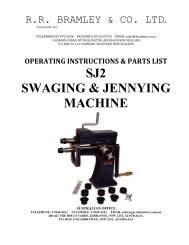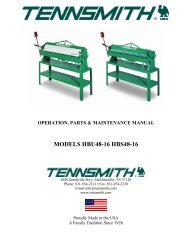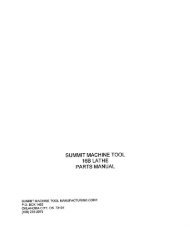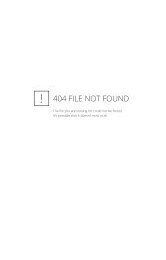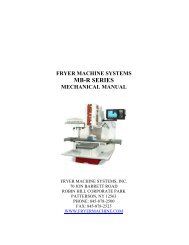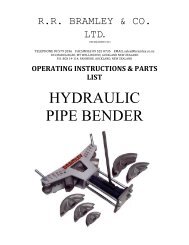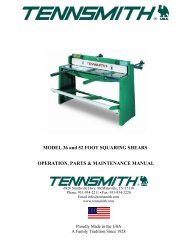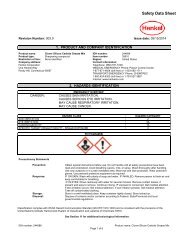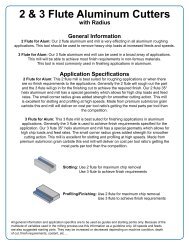MSDS - Production Tool Supply
MSDS - Production Tool Supply
MSDS - Production Tool Supply
Create successful ePaper yourself
Turn your PDF publications into a flip-book with our unique Google optimized e-Paper software.
Section 1. Identification<br />
Product name<br />
Product code :<br />
Other means of<br />
identification<br />
SAFETY DATA SHEET<br />
:<br />
:<br />
Industrial WORK DAY Enamel Spray Paint<br />
Flat Black<br />
Not available.<br />
Product type<br />
: Aerosol.<br />
Relevant identified uses of the substance or mixture and uses advised against<br />
Not applicable.<br />
4412<br />
4412<br />
Manufacturer<br />
: THE SHERWIN-WILLIAMS COMPANY<br />
KRYLON PRODUCTS GROUP<br />
Cleveland, OH 44115<br />
Emergency telephone<br />
number of the company<br />
Product Information<br />
Telephone Number<br />
Regulatory Information<br />
Telephone Number<br />
Transportation Emergency<br />
Telephone Number<br />
:<br />
(216) 566-2917<br />
: (800) 247-3266<br />
: (216) 566-2902<br />
: (800) 424-9300<br />
Section 2. Hazards identification<br />
OSHA/HCS status<br />
Classification of the<br />
substance or mixture<br />
GHS label elements<br />
Hazard pictograms :<br />
: This material is considered hazardous by the OSHA Hazard Communication Standard<br />
(29 CFR 1910.1200).<br />
:<br />
FLAMMABLE AEROSOLS - Category 1<br />
GASES UNDER PRESSURE - Compressed gas<br />
SKIN CORROSION/IRRITATION - Category 2<br />
SERIOUS EYE DAMAGE/ EYE IRRITATION - Category 2A<br />
CARCINOGENICITY - Category 2<br />
TOXIC TO REPRODUCTION (Unborn child) - Category 2<br />
SPECIFIC TARGET ORGAN TOXICITY (SINGLE EXPOSURE) (Respiratory tract<br />
irritation and Narcotic effects) - Category 3<br />
SPECIFIC TARGET ORGAN TOXICITY (REPEATED EXPOSURE) - Category 2<br />
ASPIRATION HAZARD - Category 1<br />
Percentage of the mixture consisting of ingredient(s) of unknown toxicity: 29.8%<br />
Signal word<br />
: Danger<br />
Date of issue/Date of revision : 3/13/2015. Date of previous issue : No previous validation. Version : 1 1/14
Section 2. Hazards identification<br />
Hazard statements<br />
Precautionary statements<br />
Prevention<br />
Response<br />
: Obtain special instructions before use. Do not handle until all safety precautions have<br />
been read and understood. Use personal protective equipment as required. Wear<br />
protective gloves. Wear eye or face protection. Keep away from heat, hot surfaces,<br />
sparks, open flames and other ignition sources. No smoking. Pressurized container: Do<br />
not pierce or burn, even after use. Do not spray on an open flame or other ignition<br />
source. Use only outdoors or in a well-ventilated area. Do not breathe dust or mist.<br />
Wash hands thoroughly after handling.<br />
: Get medical attention if you feel unwell. IF exposed or concerned: Get medical<br />
attention. IF INHALED: Remove victim to fresh air and keep at rest in a position<br />
comfortable for breathing. Call a POISON CENTER or physician if you feel unwell. IF<br />
SWALLOWED: Immediately call a POISON CENTER or physician. Do NOT induce<br />
vomiting. IF ON SKIN: Wash with plenty of soap and water. Take off contaminated<br />
clothing. Wash contaminated clothing before reuse. If skin irritation occurs: Get<br />
medical attention. IF IN EYES: Rinse cautiously with water for several minutes.<br />
Remove contact lenses, if present and easy to do. Continue rinsing. If eye irritation<br />
persists: Get medical attention.<br />
Storage : Store locked up. Protect from sunlight. Do not expose to temperatures exceeding 50<br />
°C/122 °F. Store in a well-ventilated place.<br />
Disposal<br />
Supplemental label<br />
elements<br />
Hazards not otherwise<br />
classified<br />
:<br />
Extremely flammable aerosol.<br />
Contains gas under pressure; may explode if heated.<br />
Causes serious eye irritation.<br />
Causes skin irritation.<br />
Suspected of damaging the unborn child.<br />
Suspected of causing cancer.<br />
May be fatal if swallowed and enters airways.<br />
May cause respiratory irritation.<br />
May cause drowsiness and dizziness.<br />
May cause damage to organs through prolonged or repeated exposure.<br />
Dispose of contents and container in accordance with all local, regional, national and<br />
international regulations.<br />
DANGER: Rags, steel wool, other waste soaked with this product, and sanding residue<br />
may spontaneously catch fire if improperly discarded. Immediately place rags, steel<br />
wool, other waste soaked with this product, and sanding residue in a sealed, water-filled,<br />
metal container. Dispose of in accordance with local fire regulations. DELAYED<br />
EFFECTS FROM LONG TERM OVEREXPOSURE. Contains solvents which can cause<br />
permanent brain and nervous system damage. Intentional misuse by deliberately<br />
concentrating and inhaling the contents can be harmful or fatal. WARNING: This<br />
product contains chemicals known to the State of California to cause cancer and birth<br />
defects or other reproductive harm. FOR INDUSTRIAL USE ONLY.<br />
Please refer to the SDS for additional information. Keep upright in a cool, dry place. Do<br />
not discard empty can in trash compactor.<br />
:None known.<br />
Section 3. Composition/information on ingredients<br />
Substance/mixture<br />
Other means of<br />
identification<br />
: Mixture<br />
: Not available.<br />
CAS number/other identifiers<br />
Date of issue/Date of revision : 3/13/2015. Date of previous issue : No previous validation. Version : 1 2/14
Section 3. Composition/information on ingredients<br />
Ingredient name<br />
% by weight<br />
CAS number<br />
Acetone 35.5 67-64-1<br />
Propane 18.0 74-98-6<br />
Butane 17.3 106-97-8<br />
Toluene 12.4 108-88-3<br />
Lt. Aliphatic Hydrocarbon Solvent 5.8 64742-89-8<br />
Carbon Black 0.2 1333-86-4<br />
There are no additional ingredients present which, within the current knowledge of the supplier and in the<br />
concentrations applicable, are classified as hazardous to health or the environment and hence require reporting<br />
in this section.<br />
Occupational exposure limits, if available, are listed in Section 8.<br />
Section 4. First aid measures<br />
Description of necessary first aid measures<br />
Eye contact<br />
Inhalation<br />
Skin contact<br />
Ingestion :<br />
:<br />
:<br />
:<br />
Immediately flush eyes with plenty of water, occasionally lifting the upper and lower<br />
eyelids. Check for and remove any contact lenses. Continue to rinse for at least 10<br />
minutes. Get medical attention.<br />
Remove victim to fresh air and keep at rest in a position comfortable for breathing. If it<br />
is suspected that fumes are still present, the rescuer should wear an appropriate mask<br />
or self-contained breathing apparatus. If not breathing, if breathing is irregular or if<br />
respiratory arrest occurs, provide artificial respiration or oxygen by trained personnel. It<br />
may be dangerous to the person providing aid to give mouth-to-mouth resuscitation.<br />
Get medical attention. If necessary, call a poison center or physician. If unconscious,<br />
place in recovery position and get medical attention immediately. Maintain an open<br />
airway. Loosen tight clothing such as a collar, tie, belt or waistband.<br />
Flush contaminated skin with plenty of water. Remove contaminated clothing and<br />
shoes. Continue to rinse for at least 10 minutes. Get medical attention. Wash clothing<br />
before reuse. Clean shoes thoroughly before reuse.<br />
Get medical attention immediately. Call a poison center or physician. Wash out mouth<br />
with water. Remove dentures if any. Remove victim to fresh air and keep at rest in a<br />
position comfortable for breathing. If material has been swallowed and the exposed<br />
person is conscious, give small quantities of water to drink. Stop if the exposed person<br />
feels sick as vomiting may be dangerous. Aspiration hazard if swallowed. Can enter<br />
lungs and cause damage. Do not induce vomiting. If vomiting occurs, the head should<br />
be kept low so that vomit does not enter the lungs. Never give anything by mouth to an<br />
unconscious person. If unconscious, place in recovery position and get medical<br />
attention immediately. Maintain an open airway. Loosen tight clothing such as a collar,<br />
tie, belt or waistband.<br />
Most important symptoms/effects, acute and delayed<br />
Potential acute health effects<br />
Eye contact<br />
Inhalation<br />
Skin contact<br />
:<br />
Causes serious eye irritation.<br />
: Can cause central nervous system (CNS) depression. May cause drowsiness and<br />
dizziness. May cause respiratory irritation.<br />
: Causes skin irritation.<br />
Ingestion<br />
: Can cause central nervous system (CNS) depression. May be fatal if swallowed and<br />
enters airways. Irritating to mouth, throat and stomach.<br />
Over-exposure signs/symptoms<br />
Eye contact<br />
: Adverse symptoms may include the following:<br />
pain or irritation<br />
watering<br />
redness<br />
Date of issue/Date of revision : 3/13/2015. Date of previous issue : No previous validation. Version : 1 3/14
Section 4. First aid measures<br />
Inhalation<br />
Skin contact<br />
Ingestion<br />
:<br />
:<br />
:<br />
Adverse symptoms may include the following:<br />
respiratory tract irritation<br />
coughing<br />
nausea or vomiting<br />
headache<br />
drowsiness/fatigue<br />
dizziness/vertigo<br />
unconsciousness<br />
reduced fetal weight<br />
increase in fetal deaths<br />
skeletal malformations<br />
Adverse symptoms may include the following:<br />
irritation<br />
redness<br />
reduced fetal weight<br />
increase in fetal deaths<br />
skeletal malformations<br />
Adverse symptoms may include the following:<br />
nausea or vomiting<br />
reduced fetal weight<br />
increase in fetal deaths<br />
skeletal malformations<br />
Indication of immediate medical attention and special treatment needed, if necessary<br />
Notes to physician<br />
Specific treatments<br />
Protection of first-aiders<br />
: Treat symptomatically. Contact poison treatment specialist immediately if large<br />
quantities have been ingested or inhaled.<br />
: No specific treatment.<br />
: No action shall be taken involving any personal risk or without suitable training. If it is<br />
suspected that fumes are still present, the rescuer should wear an appropriate mask or<br />
self-contained breathing apparatus. It may be dangerous to the person providing aid to<br />
give mouth-to-mouth resuscitation.<br />
See toxicological information (Section 11)<br />
Section 5. Fire-fighting measures<br />
Extinguishing media<br />
Suitable extinguishing<br />
media<br />
Unsuitable extinguishing<br />
media<br />
:<br />
:<br />
Use an extinguishing agent suitable for the surrounding fire.<br />
None known.<br />
Specific hazards arising<br />
from the chemical<br />
Hazardous thermal<br />
decomposition products<br />
:<br />
:<br />
Extremely flammable aerosol. In a fire or if heated, a pressure increase will occur and<br />
the container may burst, with the risk of a subsequent explosion. Gas may accumulate<br />
in low or confined areas or travel a considerable distance to a source of ignition and<br />
flash back, causing fire or explosion. Bursting aerosol containers may be propelled from<br />
a fire at high speed. Runoff to sewer may create fire or explosion hazard.<br />
Decomposition products may include the following materials:<br />
carbon dioxide<br />
carbon monoxide<br />
metal oxide/oxides<br />
Special protective actions<br />
for fire-fighters<br />
:<br />
Promptly isolate the scene by removing all persons from the vicinity of the incident if<br />
there is a fire. No action shall be taken involving any personal risk or without suitable<br />
training. Move containers from fire area if this can be done without risk. Use water<br />
spray to keep fire-exposed containers cool.<br />
Date of issue/Date of revision : 3/13/2015. Date of previous issue : No previous validation. Version : 1 4/14
Section 5. Fire-fighting measures<br />
Special protective<br />
equipment for fire-fighters<br />
:<br />
Fire-fighters should wear appropriate protective equipment and self-contained breathing<br />
apparatus (SCBA) with a full face-piece operated in positive pressure mode.<br />
Section 6. Accidental release measures<br />
Personal precautions, protective equipment and emergency procedures<br />
For non-emergency<br />
personnel<br />
For emergency responders<br />
: No action shall be taken involving any personal risk or without suitable training.<br />
Evacuate surrounding areas. Keep unnecessary and unprotected personnel from<br />
entering. In the case of aerosols being ruptured, care should be taken due to the rapid<br />
escape of the pressurized contents and propellant. If a large number of containers are<br />
ruptured, treat as a bulk material spillage according to the instructions in the clean-up<br />
section. Do not touch or walk through spilled material. Shut off all ignition sources. No<br />
flares, smoking or flames in hazard area. Avoid breathing vapor or mist. Provide<br />
adequate ventilation. Wear appropriate respirator when ventilation is inadequate. Put<br />
on appropriate personal protective equipment.<br />
: If specialised clothing is required to deal with the spillage, take note of any information in<br />
Section 8 on suitable and unsuitable materials. See also the information in "For nonemergency<br />
personnel".<br />
Environmental precautions<br />
:<br />
Avoid dispersal of spilled material and runoff and contact with soil, waterways, drains<br />
and sewers. Inform the relevant authorities if the product has caused environmental<br />
pollution (sewers, waterways, soil or air).<br />
Methods and materials for containment and cleaning up<br />
Small spill :<br />
Large spill :<br />
Section 7. Handling and storage<br />
Stop leak if without risk. Move containers from spill area. Use spark-proof tools and<br />
explosion-proof equipment. Dilute with water and mop up if water-soluble. Alternatively,<br />
or if water-insoluble, absorb with an inert dry material and place in an appropriate waste<br />
disposal container. Dispose of via a licensed waste disposal contractor.<br />
Stop leak if without risk. Move containers from spill area. Use spark-proof tools and<br />
explosion-proof equipment. Approach release from upwind. Prevent entry into sewers,<br />
water courses, basements or confined areas. Wash spillages into an effluent treatment<br />
plant or proceed as follows. Contain and collect spillage with non-combustible,<br />
absorbent material e.g. sand, earth, vermiculite or diatomaceous earth and place in<br />
container for disposal according to local regulations (see Section 13). Dispose of via a<br />
licensed waste disposal contractor. Contaminated absorbent material may pose the<br />
same hazard as the spilled product. Note: see Section 1 for emergency contact<br />
information and Section 13 for waste disposal.<br />
Precautions for safe handling<br />
Protective measures<br />
Advice on general<br />
occupational hygiene<br />
:<br />
:<br />
Put on appropriate personal protective equipment (see Section 8). Pressurized<br />
container: protect from sunlight and do not expose to temperatures exceeding 50°C. Do<br />
not pierce or burn, even after use. Avoid exposure - obtain special instructions before<br />
use. Avoid exposure during pregnancy. Do not handle until all safety precautions have<br />
been read and understood. Do not get in eyes or on skin or clothing. Do not breathe<br />
vapor or mist. Do not swallow. Avoid breathing gas. Use only with adequate ventilation.<br />
Wear appropriate respirator when ventilation is inadequate. Store and use away from<br />
heat, sparks, open flame or any other ignition source. Use explosion-proof electrical<br />
(ventilating, lighting and material handling) equipment. Use only non-sparking tools.<br />
Empty containers retain product residue and can be hazardous.<br />
Eating, drinking and smoking should be prohibited in areas where this material is<br />
handled, stored and processed. Workers should wash hands and face before eating,<br />
drinking and smoking. Remove contaminated clothing and protective equipment before<br />
entering eating areas. See also Section 8 for additional information on hygiene<br />
measures.<br />
Date of issue/Date of revision : 3/13/2015. Date of previous issue : No previous validation. Version : 1 5/14
Section 7. Handling and storage<br />
Conditions for safe storage,<br />
including any<br />
incompatibilities<br />
:<br />
Store in accordance with local regulations. Store away from direct sunlight in a dry, cool<br />
and well-ventilated area, away from incompatible materials (see Section 10) and food<br />
and drink. Protect from sunlight. Store locked up. Eliminate all ignition sources. Use<br />
appropriate containment to avoid environmental contamination.<br />
Section 8. Exposure controls/personal protection<br />
Control parameters<br />
Occupational exposure limits<br />
Ingredient name<br />
Exposure limits<br />
Acetone ACGIH TLV (United States, 4/2014).<br />
TWA: 500 ppm 8 hours.<br />
TWA: 1188 mg/m³ 8 hours.<br />
STEL: 750 ppm 15 minutes.<br />
STEL: 1782 mg/m³ 15 minutes.<br />
NIOSH REL (United States, 10/2013).<br />
TWA: 250 ppm 10 hours.<br />
TWA: 590 mg/m³ 10 hours.<br />
OSHA PEL (United States, 2/2013).<br />
TWA: 1000 ppm 8 hours.<br />
TWA: 2400 mg/m³ 8 hours.<br />
Propane NIOSH REL (United States, 10/2013).<br />
TWA: 1000 ppm 10 hours.<br />
TWA: 1800 mg/m³ 10 hours.<br />
OSHA PEL (United States, 2/2013).<br />
TWA: 1000 ppm 8 hours.<br />
TWA: 1800 mg/m³ 8 hours.<br />
Butane NIOSH REL (United States, 10/2013).<br />
TWA: 800 ppm 10 hours.<br />
TWA: 1900 mg/m³ 10 hours.<br />
ACGIH TLV (United States, 4/2014).<br />
STEL: 1000 ppm 15 minutes.<br />
Toluene OSHA PEL Z2 (United States, 2/2013).<br />
TWA: 200 ppm 8 hours.<br />
CEIL: 300 ppm<br />
AMP: 500 ppm 10 minutes.<br />
NIOSH REL (United States, 10/2013).<br />
TWA: 100 ppm 10 hours.<br />
TWA: 375 mg/m³ 10 hours.<br />
STEL: 150 ppm 15 minutes.<br />
STEL: 560 mg/m³ 15 minutes.<br />
ACGIH TLV (United States, 4/2014).<br />
TWA: 20 ppm 8 hours.<br />
Carbon Black NIOSH REL (United States, 10/2013).<br />
TWA: 3.5 mg/m³ 10 hours.<br />
TWA: 0.1 mg of PAHs/cm³ 10 hours.<br />
OSHA PEL (United States, 2/2013).<br />
TWA: 3.5 mg/m³ 8 hours.<br />
ACGIH TLV (United States, 4/2014).<br />
TWA: 3 mg/m³ 8 hours. Form: Inhalable<br />
fraction<br />
Appropriate engineering<br />
controls<br />
: Use only with adequate ventilation. Use process enclosures, local exhaust ventilation or<br />
other engineering controls to keep worker exposure to airborne contaminants below any<br />
recommended or statutory limits. The engineering controls also need to keep gas,<br />
vapor or dust concentrations below any lower explosive limits. Use explosion-proof<br />
ventilation equipment.<br />
Date of issue/Date of revision : 3/13/2015. Date of previous issue : No previous validation. Version : 1 6/14
Section 8. Exposure controls/personal protection<br />
Environmental exposure<br />
controls<br />
: Emissions from ventilation or work process equipment should be checked to ensure<br />
they comply with the requirements of environmental protection legislation. In some<br />
cases, fume scrubbers, filters or engineering modifications to the process equipment<br />
will be necessary to reduce emissions to acceptable levels.<br />
Individual protection measures<br />
Hygiene measures :<br />
Eye/face protection<br />
Skin protection<br />
Hand protection<br />
Body protection<br />
Other skin protection<br />
Respiratory protection :<br />
:<br />
:<br />
:<br />
Wash hands, forearms and face thoroughly after handling chemical products, before<br />
eating, smoking and using the lavatory and at the end of the working period.<br />
Appropriate techniques should be used to remove potentially contaminated clothing.<br />
Wash contaminated clothing before reusing. Ensure that eyewash stations and safety<br />
showers are close to the workstation location.<br />
Safety eyewear complying with an approved standard should be used when a risk<br />
assessment indicates this is necessary to avoid exposure to liquid splashes, mists,<br />
gases or dusts. If contact is possible, the following protection should be worn, unless<br />
the assessment indicates a higher degree of protection: chemical splash goggles.<br />
Chemical-resistant, impervious gloves complying with an approved standard should be<br />
worn at all times when handling chemical products if a risk assessment indicates this is<br />
necessary. Considering the parameters specified by the glove manufacturer, check<br />
during use that the gloves are still retaining their protective properties. It should be<br />
noted that the time to breakthrough for any glove material may be different for different<br />
glove manufacturers. In the case of mixtures, consisting of several substances, the<br />
protection time of the gloves cannot be accurately estimated.<br />
Personal protective equipment for the body should be selected based on the task being<br />
performed and the risks involved and should be approved by a specialist before<br />
handling this product. When there is a risk of ignition from static electricity, wear antistatic<br />
protective clothing. For the greatest protection from static discharges, clothing<br />
should include anti-static overalls, boots and gloves.<br />
: Appropriate footwear and any additional skin protection measures should be selected<br />
based on the task being performed and the risks involved and should be approved by a<br />
specialist before handling this product.<br />
Use a properly fitted, air-purifying or air-fed respirator complying with an approved<br />
standard if a risk assessment indicates this is necessary. Respirator selection must be<br />
based on known or anticipated exposure levels, the hazards of the product and the safe<br />
working limits of the selected respirator.<br />
Section 9. Physical and chemical properties<br />
Appearance<br />
Physical state<br />
Color<br />
Odor<br />
Odor threshold<br />
pH<br />
Melting point<br />
Boiling point<br />
Flash point<br />
Vapor pressure<br />
Vapor density<br />
Relative density<br />
Liquid.<br />
Not available.<br />
Not available.<br />
Not available.<br />
7<br />
Not available.<br />
Evaporation rate : 5.6 (butyl acetate = 1)<br />
Flammability (solid, gas)<br />
Lower and upper explosive<br />
(flammable) limits<br />
:<br />
:<br />
:<br />
:<br />
:<br />
:<br />
: Not available.<br />
:<br />
:<br />
:<br />
:<br />
Closed cup: -29°C (-20.2°F) [Pensky-Martens Closed Cup]<br />
: Not available.<br />
: Lower: 0.9%<br />
Upper: 12.8%<br />
13.5 kPa (101.325 mm Hg) [at 20°C]<br />
1.55 [Air = 1]<br />
0.71<br />
Date of issue/Date of revision : 3/13/2015. Date of previous issue : No previous validation. Version : 1 7/14
Section 9. Physical and chemical properties<br />
Solubility<br />
Partition coefficient: n-<br />
octanol/water<br />
Auto-ignition temperature<br />
Decomposition temperature<br />
Viscosity<br />
Aerosol product<br />
Type of aerosol<br />
Heat of combustion<br />
:<br />
:<br />
:<br />
:<br />
Not available.<br />
Not available.<br />
Not available.<br />
: Not available.<br />
Kinematic (room temperature):
Section 11. Toxicological information<br />
Sensitization<br />
Not available.<br />
Micrograms<br />
Eyes - Severe irritant Rabbit - 24 hours 2<br />
milligrams<br />
Skin - Mild irritant Pig - 24 hours 250<br />
microliters<br />
Skin - Mild irritant Rabbit - 435<br />
milligrams<br />
Skin - Moderate irritant Rabbit - 24 hours 20<br />
milligrams<br />
Skin - Moderate irritant Rabbit - 500<br />
milligrams<br />
-<br />
-<br />
-<br />
-<br />
-<br />
Mutagenicity<br />
Not available.<br />
Carcinogenicity<br />
Not available.<br />
Classification<br />
Product/ingredient name<br />
Reproductive toxicity<br />
Not available.<br />
Teratogenicity<br />
Not available.<br />
Specific target organ toxicity (single exposure)<br />
Name<br />
Acetone Category 3 Not applicable. Respiratory tract<br />
irritation and<br />
Narcotic effects<br />
Propane Category 3 Not applicable. Respiratory tract<br />
irritation and<br />
Narcotic effects<br />
Butane Category 3 Not applicable. Respiratory tract<br />
irritation and<br />
Narcotic effects<br />
Toluene Category 3 Not applicable. Respiratory tract<br />
irritation and<br />
Narcotic effects<br />
Lt. Aliphatic Hydrocarbon Solvent Category 3 Not applicable. Respiratory tract<br />
irritation and<br />
Narcotic effects<br />
Specific target organ toxicity (repeated exposure)<br />
Name<br />
OSHA<br />
IARC<br />
Toluene - 3 -<br />
Carbon Black - 2B -<br />
NTP<br />
Category<br />
Category<br />
Route of<br />
exposure<br />
Route of<br />
exposure<br />
Target organs<br />
Target organs<br />
Acetone Category 2 Not determined Not determined<br />
Propane Category 2 Not determined Not determined<br />
Butane Category 2 Not determined Not determined<br />
Toluene Category 2 Not determined Not determined<br />
Lt. Aliphatic Hydrocarbon Solvent Category 2 Not determined Not determined<br />
Date of issue/Date of revision : 3/13/2015. Date of previous issue : No previous validation. Version : 1 9/14
Section 11. Toxicological information<br />
Aspiration hazard<br />
Name<br />
Result<br />
Propane ASPIRATION HAZARD - Category 1<br />
Butane ASPIRATION HAZARD - Category 1<br />
Toluene ASPIRATION HAZARD - Category 1<br />
Lt. Aliphatic Hydrocarbon Solvent ASPIRATION HAZARD - Category 1<br />
Information on the likely<br />
routes of exposure<br />
Potential acute health effects<br />
Eye contact<br />
Inhalation<br />
Skin contact<br />
Ingestion<br />
:<br />
: Can cause central nervous system (CNS) depression. May cause drowsiness and<br />
dizziness. May cause respiratory irritation.<br />
: Causes skin irritation.<br />
:<br />
Causes serious eye irritation.<br />
Can cause central nervous system (CNS) depression. May be fatal if swallowed and<br />
enters airways. Irritating to mouth, throat and stomach.<br />
Symptoms related to the physical, chemical and toxicological characteristics<br />
Eye contact<br />
Inhalation<br />
Skin contact<br />
Ingestion<br />
: Not available.<br />
: Adverse symptoms may include the following:<br />
pain or irritation<br />
watering<br />
redness<br />
: Adverse symptoms may include the following:<br />
respiratory tract irritation<br />
coughing<br />
nausea or vomiting<br />
headache<br />
drowsiness/fatigue<br />
dizziness/vertigo<br />
unconsciousness<br />
reduced fetal weight<br />
increase in fetal deaths<br />
skeletal malformations<br />
: Adverse symptoms may include the following:<br />
irritation<br />
redness<br />
reduced fetal weight<br />
increase in fetal deaths<br />
skeletal malformations<br />
: Adverse symptoms may include the following:<br />
nausea or vomiting<br />
reduced fetal weight<br />
increase in fetal deaths<br />
skeletal malformations<br />
Delayed and immediate effects and also chronic effects from short and long term exposure<br />
Short term exposure<br />
Potential immediate<br />
effects<br />
Potential delayed effects<br />
Long term exposure<br />
Potential immediate<br />
effects<br />
: Not available.<br />
: Not available.<br />
: Not available.<br />
Date of issue/Date of revision : 3/13/2015. Date of previous issue : No previous validation. Version : 1 10/14
Potential delayed effects : Not available.<br />
Potential chronic health effects<br />
Not available.<br />
General : May cause damage to organs through prolonged or repeated exposure.<br />
Carcinogenicity : Suspected of causing cancer. Risk of cancer depends on duration and level of<br />
exposure.<br />
Mutagenicity : No known significant effects or critical hazards.<br />
Teratogenicity : Suspected of damaging the unborn child.<br />
Developmental effects : No known significant effects or critical hazards.<br />
Fertility effects<br />
: No known significant effects or critical hazards.<br />
Numerical measures of toxicity<br />
Acute toxicity estimates<br />
Route<br />
Oral<br />
ATE value<br />
3608.4 mg/kg<br />
Section 12. Ecological information<br />
Toxicity<br />
Product/ingredient name<br />
Acetone Acute EC50 20.565 mg/l Marine water Algae - Ulva pertusa 96 hours<br />
Acute LC50 6000000 µg/l Fresh water Crustaceans - Gammarus pulex 48 hours<br />
Acute LC50 10000 µg/l Fresh water Daphnia - Daphnia magna 48 hours<br />
Acute LC50 5600 ppm Fresh water Fish - Poecilia reticulata 96 hours<br />
Chronic NOEC 4.95 mg/l Marine water Algae - Ulva pertusa 96 hours<br />
Chronic NOEC 0.016 ml/L Fresh water Crustaceans - Daphniidae 21 days<br />
Chronic NOEC 0.1 ml/L Fresh water Daphnia - Daphnia magna - 21 days<br />
Neonate<br />
Chronic NOEC 5 µg/l Marine water Fish - Gasterosteus aculeatus - 42 days<br />
Larvae<br />
Toluene Acute EC50 12500 µg/l Fresh water Algae - Pseudokirchneriella 72 hours<br />
subcapitata<br />
Acute EC50 11600 µg/l Fresh water Crustaceans - Gammarus 48 hours<br />
pseudolimnaeus - Adult<br />
Acute EC50 6000 µg/l Fresh water Daphnia - Daphnia magna - 48 hours<br />
Juvenile (Fledgling, Hatchling,<br />
Weanling)<br />
Acute LC50 5500 µg/l Fresh water Fish - Oncorhynchus kisutch - Fry 96 hours<br />
Lt. Aliphatic Hydrocarbon<br />
Solvent<br />
Result<br />
Species<br />
Exposure<br />
Chronic NOEC 1000 µg/l Fresh water Daphnia - Daphnia magna 21 days<br />
Acute LC50 >100000 ppm Fresh water Fish - Oncorhynchus mykiss 96 hours<br />
Persistence and degradability<br />
Product/ingredient name Aquatic half-life Photolysis Biodegradability<br />
Acetone - - Readily<br />
Toluene - - Readily<br />
Bioaccumulative potential<br />
Date of issue/Date of revision : 3/13/2015. Date of previous issue : No previous validation. Version : 1 11/14
Section 12. Ecological information<br />
Product/ingredient name<br />
LogPow BCF Potential<br />
Toluene - 90 low<br />
Lt. Aliphatic Hydrocarbon - 10 to 2500 high<br />
Solvent<br />
Mobility in soil<br />
Soil/water partition<br />
coefficient (KOC)<br />
: Not available.<br />
Other adverse effects<br />
: No known significant effects or critical hazards.<br />
Section 13. Disposal considerations<br />
Disposal methods<br />
Section 14. Transport information<br />
:<br />
The generation of waste should be avoided or minimized wherever possible. Disposal<br />
of this product, solutions and any by-products should at all times comply with the<br />
requirements of environmental protection and waste disposal legislation and any<br />
regional local authority requirements. Dispose of surplus and non-recyclable products<br />
via a licensed waste disposal contractor. Waste should not be disposed of untreated to<br />
the sewer unless fully compliant with the requirements of all authorities with jurisdiction.<br />
Waste packaging should be recycled. Incineration or landfill should only be considered<br />
when recycling is not feasible. This material and its container must be disposed of in a<br />
safe way. Empty containers or liners may retain some product residues. Do not<br />
puncture or incinerate container.<br />
DOT<br />
Classification<br />
TDG<br />
Classification<br />
Mexico<br />
Classification<br />
IATA<br />
IMDG<br />
UN number<br />
UN1950<br />
UN1950<br />
UN1950<br />
UN1950<br />
UN1950<br />
UN proper<br />
shipping name<br />
AEROSOLS<br />
AEROSOLS<br />
AEROSOLS<br />
AEROSOLS,<br />
flammable<br />
AEROSOLS<br />
Transport<br />
hazard class(es)<br />
2.1<br />
2.1<br />
2.1<br />
2.1<br />
2.1<br />
Packing group<br />
-<br />
-<br />
-<br />
-<br />
-<br />
Environmental<br />
hazards<br />
No.<br />
No.<br />
No.<br />
No.<br />
No.<br />
Additional<br />
information<br />
Special<br />
provisions<br />
LIMITED<br />
QUANTITY<br />
Special<br />
provisions<br />
LIMITED<br />
QUANTITY<br />
Special<br />
provisions<br />
(ERG#126)<br />
Special<br />
provisions<br />
LIMITED<br />
QUANTITY<br />
Emergency<br />
schedules (EmS)<br />
LIMITED<br />
QUANTITY, F-D,<br />
S-U<br />
Special precautions for user<br />
:<br />
Multi-modal shipping descriptions are provided for informational purposes and do not<br />
consider container sizes. The presence of a shipping description for a particular<br />
mode of transport (sea, air, etc.), does not indicate that the product is packaged<br />
suitably for that mode of transport. All packaging must be reviewed for suitability prior<br />
to shipment, and compliance with the applicable regulations is the sole responsibility<br />
of the person offering the product for transport. People loading and unloading<br />
dangerous goods must be trained on all of the risks deriving from the substances<br />
and on all actions in case of emergency situations.<br />
Date of issue/Date of revision : 3/13/2015. Date of previous issue : No previous validation. Version : 1 12/14
Section 14. Transport information<br />
Transport in bulk according<br />
to Annex II of MARPOL<br />
73/78 and the IBC Code<br />
: Not available.<br />
Section 15. Regulatory information<br />
U.S. Federal regulations :<br />
State regulations<br />
California Prop. 65<br />
WARNING: This product contains chemicals known to the State of California to cause cancer and birth defects or other<br />
reproductive harm.<br />
Section 16. Other information<br />
Hazardous Material Information System (U.S.A.)<br />
Health<br />
Flammability<br />
Physical hazards<br />
*<br />
2<br />
4<br />
0<br />
Caution: HMIS® ratings are based on a 0-4 rating scale, with 0 representing minimal hazards or risks, and 4<br />
representing significant hazards or risks Although HMIS® ratings are not required on SDSs under 29 CFR 1910.<br />
1200, the preparer may choose to provide them. HMIS® ratings are to be used with a fully implemented HMIS®<br />
program. HMIS® is a registered mark of the National Paint & Coatings Association (NPCA). HMIS® materials may<br />
be purchased exclusively from J. J. Keller (800) 327-6868.<br />
The customer is responsible for determining the PPE code for this material.<br />
Notice to reader<br />
It is recommended that each customer or recipient of this Safety Data Sheet (SDS) study it carefully and consult<br />
resources, as necessary or appropriate, to become aware of and understand the data contained in this SDS and<br />
any hazards associated with the product. This information is provided in good faith and believed to be accurate<br />
as of the effective date herein. However, no warranty, express or implied, is given. The information presented<br />
here applies only to the product as shipped. The addition of any material can change the composition, hazards<br />
and risks of the product. Regulatory requirements are subject to change and may differ between various<br />
locations and jurisdictions. The customer/buyer/user is responsible to ensure that his activities comply with all<br />
country, federal, state, provincial or local laws. The conditions for use of the product are not under the control of<br />
the manufacturer; the customer/buyer/user is responsible to determine the conditions necessary for the safe use<br />
of this product. The customer/buyer/user should not use the product for any purpose other than the purpose<br />
shown in the applicable section of this SDS without first referring to the supplier and obtaining written handling<br />
instructions. Due to the proliferation of sources for information such as manufacturer-specific SDS, the<br />
Date of issue/Date of revision : 3/13/2015. Date of previous issue : No previous validation. Version : 1 13/14
Section 16. Other information<br />
manufacturer cannot be responsible for SDSs obtained from any other source.<br />
Date of issue/Date of revision : 3/13/2015. Date of previous issue : No previous validation. Version : 1 14/14




